Wen-Qin Wang
Multipath Identification and Mitigation with FDA-MIMO Radar
Jul 25, 2024



Abstract:In smart city development, the automatic detection of structures and vehicles within urban or suburban areas via array radar (airborne or vehicle platforms) becomes crucial. However, the inescapable multipath effect adversely affects the radar's capability to detect and track targets. Frequency Diversity Array (FDA)-MIMO radar offers innovative solutions in mitigating multipath due to its frequency flexibility and waveform diversity traits amongst array elements. Hence, utilizing FDA-MIMO radar, this research proposes a multipath discrimination and suppression strategy to augment target detection and suppress false alarms. The primary advancement is the transformation of conventional multipath suppression into a multipath recognition issue, thereby enabling multipath components from single-frame echo data to be separated without prior knowledge. By offsetting the distance steering vectors of different objects to be detected, the accurate spectral information corresponding to the current distance unit can be extracted during spatial spectrum estimation. The direct and multipath components are differentiated depending on whether the transmitting and receiving angles match. Additionally, to mitigate high-order multipath, the echo intensity of multipath components is reduced via joint optimization of array transmit weighting and frequency increment. The numerical results show that the proposed algorithm can identify multipath at different distances in both single-target and multi-target scenarios, which is superior to the general MIMO radar.
Adaptive Target Detection for FDA-MIMO Radar with Training Data in Gaussian noise
Mar 21, 2024



Abstract:This paper addresses the problem of detecting a moving target embedded in Gaussian noise with an unknown covariance matrix for frequency diverse array multiple-input multiple-output (FDA-MIMO) radar. To end it, assume that obtaining a set of training data is available. Moreover, we propose three adaptive detectors in accordance with the one-step generalized likelihood ratio test (GLRT), two-step GLRT, and Rao criteria, namely OGLRT, TGLRT, and Rao. The LH adaptive matched filter (LHAMF) detector is also introduced when decomposing the Rao test. Next, all provided detectors have constant false alarm rate (CFAR) properties against the covariance matrix. Besides, the closed-form expressions for false alarm probability (PFA) and detection probability (PD) are derived. Finally, this paper substantiates the correctness of the aforementioned algorithms through numerical simulations.
FDA-MIMO-based Integrated Sensing and Communication System with Frequency Offset Permutation Index Modulation
Dec 22, 2023Abstract:Considering that frequency diverse array multiple-input multiple-output (FDA-MIMO) possesses extra range information to enhance sensing performance, this paper explores the FDA-MIMO-based integrated sensing and communication (ISAC) system. To reinforce the system communication capability, we propose the frequency offset permutation index modulation (FOPIM) scheme, which conveys extra information bits by selecting and permutating frequency offsets from a frequency offsets pool. For the system communication sub-functionality, considering the fact that the traditional maximum likelihood detection method suffers from high complexity and bit error rate (BER), the maximum likelihood-based two-stage detection (MLTSD) approach is presented to overcome this issue. For the system sensing sub-function, we employ the two-step maximum likelihood estimator (TSMLE) to stepwise estimate the angle and range of the interested target. Furthermore, we derive the closed-form expressions for the tight upper bound on the communication BER, along with the sensing Cram\'er-Rao bound (CRB). The simulation results validate the theoretical analysis, demonstrating that the proposed system exhibits lower BER and superior range resolution than independent MIMO communication and MIMO sensing modules.
On Smart Morphing Wing Aircraft Robust Adaptive Beamforming
Dec 22, 2023Abstract:The smart morphing wing aircraft (SMWA) is a highly adaptable platform that can be widely used for intelligent warfare due to its real-time variable structure. The flexible conformal array (FCA) is a vital detection component of SMWA, when the deformation parameters of FCA are mismatched or array elements are mutually coupled, detection performance will be degraded. To overcome this problem and ensure robust beamforming for FCA, deviations in array control parameters (ACPs) and array perturbations, the effect of mutual coupling in addition to looking-direction errors should be considered. In this paper, we propose a robust adaptive beamforming (RAB) algorithm by reconstructing a multi-domain interference plus noise covariance matrix (INCM) and estimating steering vector (SV) for FCA. We first reconstruct the INCM using multi-domain processing, including ACP and angular domains. Then, SV estimation is executed through an optimization procedure. Experimental results have shown that the proposed beamformer outperforms existing beamformers in various mismatch conditions and harsh environments, such as high interference-to-noise ratios, and mutual coupling of antennas.
Coherent FDA Receiver and Joint Range-Space-Time Processing
Jun 01, 2023Abstract:When a target is masked by mainlobe clutter with the same Doppler frequency, it is difficult for conventional airborne radars to determine whether a target is present in a given observation using regular space-time adaptive processing techniques. Different from phased-array and multiple-input multiple-output (MIMO) arrays, frequency diverse arrays (FDAs) employ frequency offsets across the array elements, delivering additional range-controllable degrees of freedom, potentially enabling suppression for this kind of clutter. However, the reception of coherent FDA systems employing small frequency offsets and achieving high transmit gain can be further improved. To this end, this work proposes an coherent airborne FDA radar receiver that explores the orthogonality of echo signals in the Doppler domain, allowing a joint space-time processing module to be deployed to separate the aliased returns. The resulting range-space-time adaptive processing allows for a preferable detection performance for coherent airborne FDA radars as compared to current alternative techniques.
FDA Beampattern Characteristics With Considering Time-Range Relations
Apr 14, 2022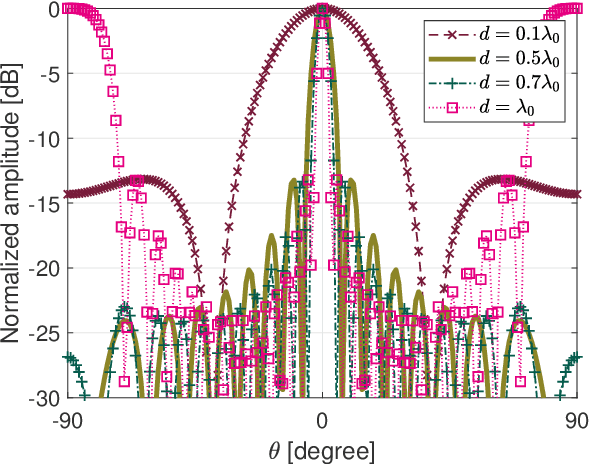
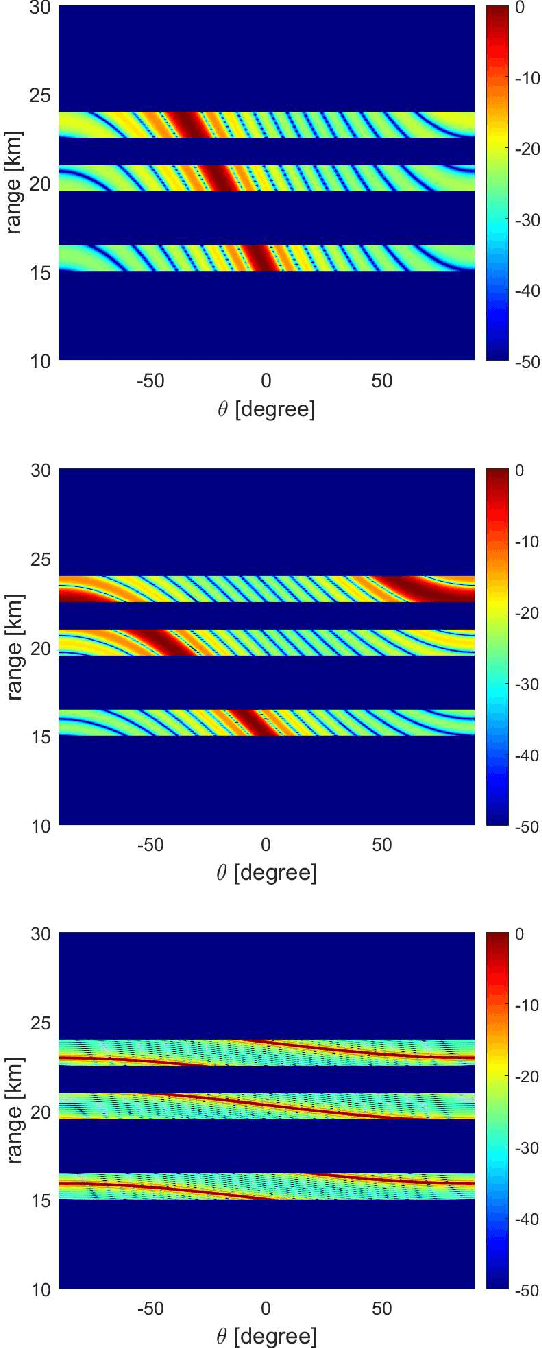
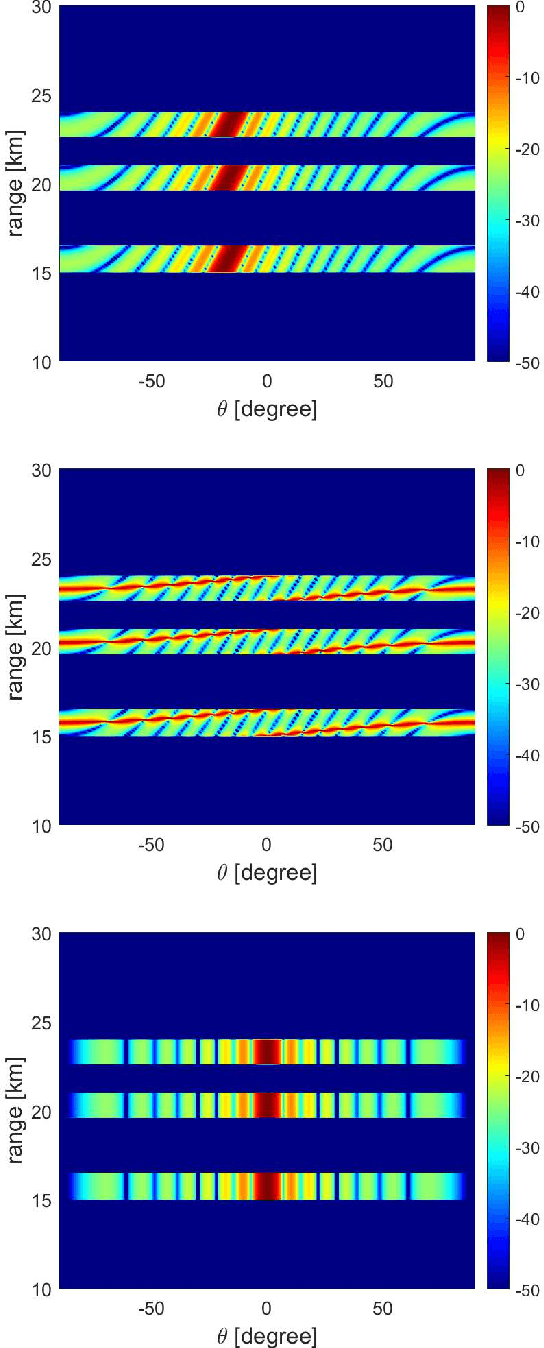
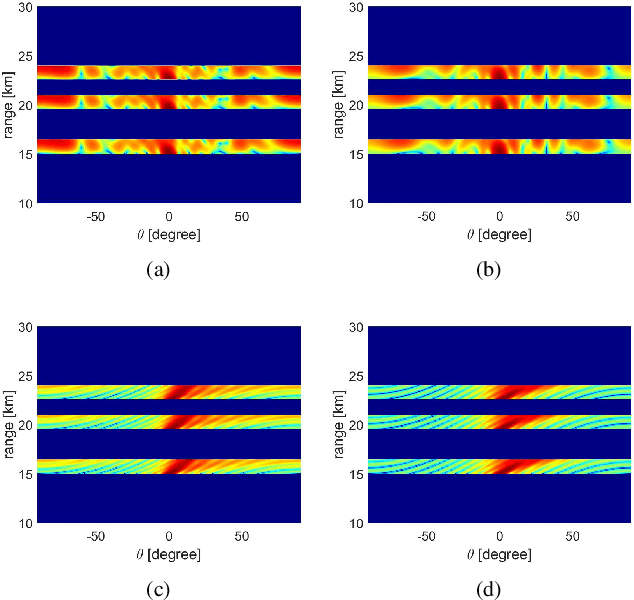
Abstract:Existing investigations show that frequency diverse array (FDA) will produce angle-range-dependent and time-variant transmit beampattern, but the relations between time and range and their characteristics still are not fully investigated. In order to fully exploit the time and range dependent characteristics of FDA transmit beampattern and address the effects of FDA frequency offsets, we systematically reformulate the FDA antenna and system model with specific time-range relation consideration. Two FDA transmit beampatterns, namely, instantaneous and integral ones, are derived. Accordingly, the FDA time and range dependent characteristics together with the comparisons to conventional phased-array and co-located multiple-input multiple-output (MIMO) antennas are analyzed. Both theoretical analysis and simulation results reveal that the FDA time-range dependent characteristics actually can be regarded as auto-scanning capability, which may provide many promising applications.
Coherent FDA Radar Systems: Joint Design of Transmitting and Receiving Array Weighters
Apr 14, 2022

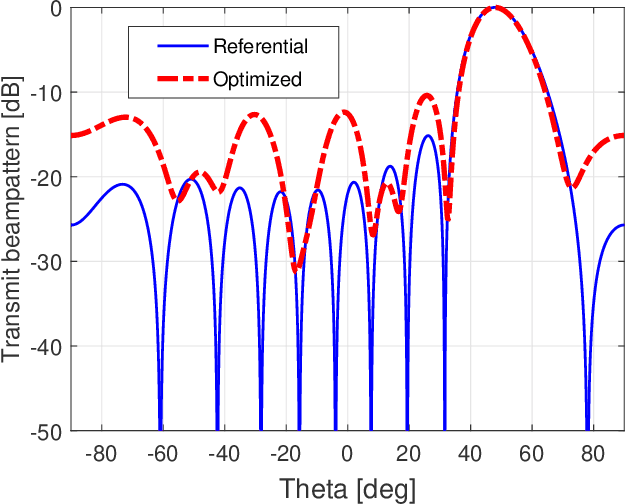
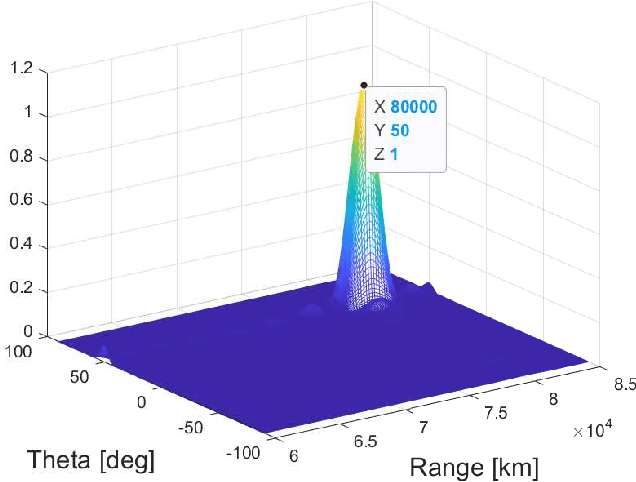
Abstract:Due to the frequency offset across its array elements, frequency diverse array (FDA) will generate angle-range-dependent and time-variant transmit beampattern. Since existing investigations usually focus on FDA transmitter and only instantaneous beampattern is considered, which cannot fully exploit the time-range characteristics of FDA radar for enhanced performance, in this paper we formulate a multi-carrier mixing receiver for coherent pulsed-Doppler FDA radar to effectively retain the range information of FDA radar returned signals in subsequent receiver processing. Accordingly, the joint transmitter and receiver is systematically modeled with time-range relationship consideration. More importantly, we optimally design the joint transmitting and receiving weighters by maximizing the radiated energy within the desired range-angle sections for given total energy. All proposed methods are verified by simulation results.
Designing FDA Radars Robust to Contaminated Shared Spectra
Apr 14, 2022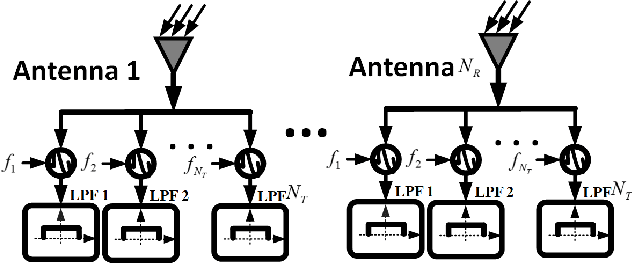
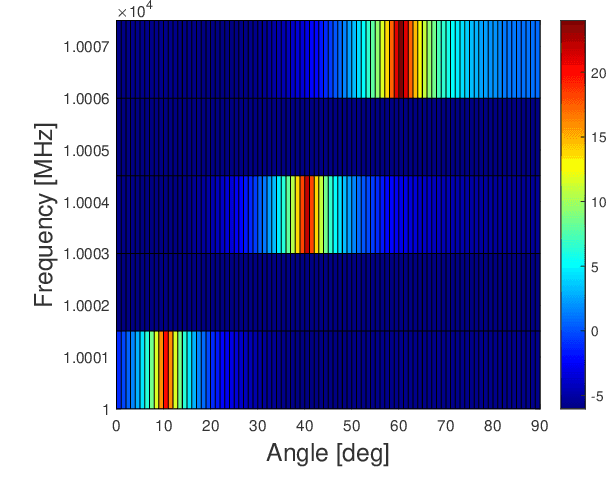
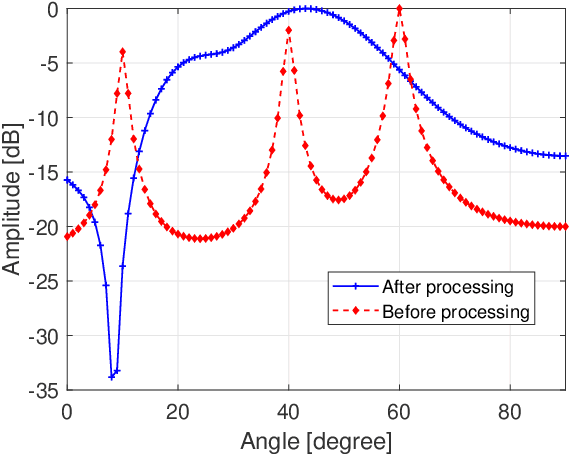

Abstract:This paper considers the problem of jointly designing the transmit waveforms and weights for a frequency diverse array (FDA) in a spectrally congested environment in which unintentional spectral interferences exist. Exploiting the properties of the interference signal induced by the processing of the multi-channel mixing and low-pass filtering FDA receiver, the interference covariance matrix structure is derived. With this, the receive weights are formed using the minimum variance distortionless response (MVDR) method for interference cancellation. Owing to the fact that the resulting output signal-to-interference-plus-noise ratio (SINR) is a function of the transmit waveforms and weights, as well as due to the ever-greater competition for the finite available spectrum, a joint design scheme for the FDA transmit weights and the spectrally compatible waveforms is proposed to efficiently use the available spectrum while maintaining a sufficient receive SINR. The performance of the proposed technique is verified using numerical simulations in terms of the achievable SINR, spectral compatiblity, as well as several aspects of the synthesized waveforms.
Waveform Optimization with SINR Criteria for FDA Radar in the Presence of Signal-Dependent Mainlobe Interference
Apr 14, 2022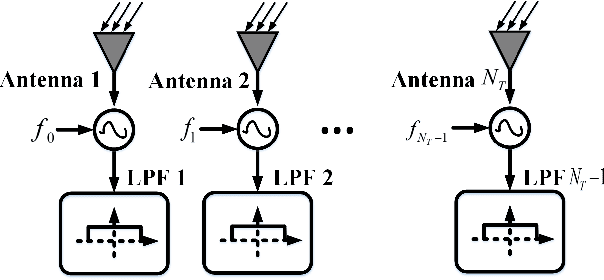
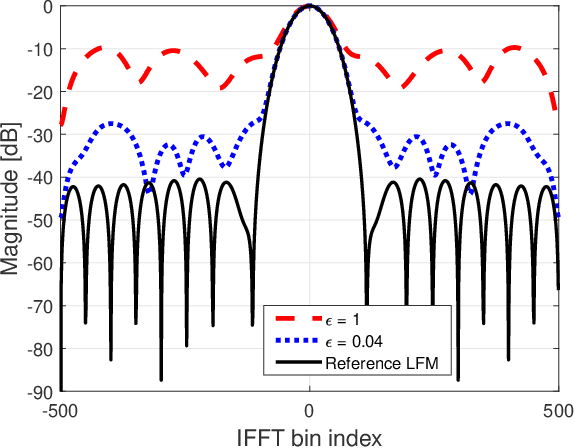


Abstract:In this paper, we focus on the design of the transmit waveforms of a frequency diverse array (FDA) in order to improve the output signal-to-interference-plus-noise ratio (SINR) in the presence of signal-dependent mainlobe interference. Since the classical multi-carrier matched filtering-based FDA receiver cannot effectively utilize the waveform diversity of FDA, a novel FDA receiver framework based on multi-channel mixing and low-pass filtering is developed to keep the separation of the transmit waveform at the receiver side, while preserving the FDA range-controllable degrees of freedom. Furthermore, a range-angle minimum variance distortionless response beamforming technique is introduced to synthesize receiver filter weights with the ability to suppress a possible signal-dependent mainlobe interference. The resulting FDA transmit waveform design problem is initially formulated as an optimization problem consisting of a non-convex objective function and multiple non-convex constraints. To efficiently slove this, we introduce two algorithms, one based on a signal relaxation technique, and the other based on the majorization minimization technique. The preferable performance of the proposed multi-channel low-pass filtering receiver and the optimized transmit waveforms is illustrated using numerical simulations, indicating that the resulting FDA system is not only able to effectively suppress mainlobe interference, but also to yield estimates with a higher SINR than the FDA system without waveform optimization.
 Add to Chrome
Add to Chrome Add to Firefox
Add to Firefox Add to Edge
Add to Edge